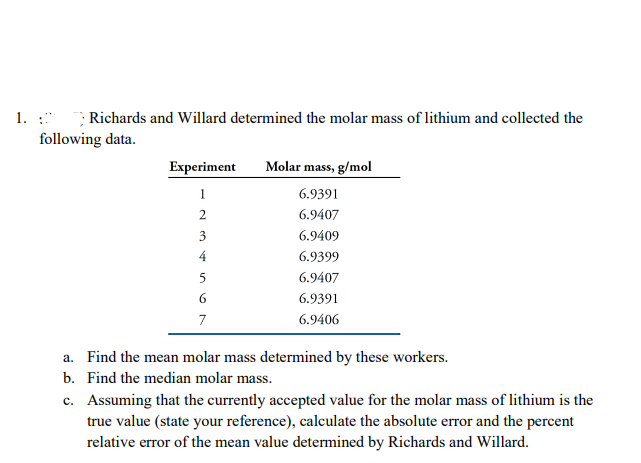1. : following data. Richards and Willard determined the molar mass of lithium and collected the Experiment Molar mass, g/mol 6.9391 2 6.9407 3 6.9409 4 6.9399 5 6.9407 6 6.9391 7 6.9406 a. Find the mean molar mass determined by these workers. b. Find the median molar mass. c. Assuming that the currently accepted value for the molar mass of lithium is the true value (state your reference), calculate the absolute error and the percent relative error of the mean value determined by Richards and Willard.
1. : following data. Richards and Willard determined the molar mass of lithium and collected the Experiment Molar mass, g/mol 6.9391 2 6.9407 3 6.9409 4 6.9399 5 6.9407 6 6.9391 7 6.9406 a. Find the mean molar mass determined by these workers. b. Find the median molar mass. c. Assuming that the currently accepted value for the molar mass of lithium is the true value (state your reference), calculate the absolute error and the percent relative error of the mean value determined by Richards and Willard.
Introductory Chemistry: An Active Learning Approach
6th Edition
ISBN:9781305079250
Author:Mark S. Cracolice, Ed Peters
Publisher:Mark S. Cracolice, Ed Peters
Chapter16: Solutions
Section: Chapter Questions
Problem 31E
Related questions
Question
Please show the complete solution for the table given in the image. Thank you!

Transcribed Image Text:1. : Richards and Willard determined the molar mass of lithium and collected the
following data.
Experiment
Molar mass, g/mol
1
6.9391
6.9407
3
6.9409
4
6.9399
6.9407
6
6.9391
7
6.9406
a. Find the mean molar mass determined by these workers.
b. Find the median molar mass.
c. Assuming that the currently accepted value for the molar mass of lithium is the
true value (state your reference), calculate the absolute error and the percent
relative error of the mean value determined by Richards and Willard.
Expert Solution
This question has been solved!
Explore an expertly crafted, step-by-step solution for a thorough understanding of key concepts.
This is a popular solution!
Trending now
This is a popular solution!
Step by step
Solved in 3 steps

Knowledge Booster
Learn more about
Need a deep-dive on the concept behind this application? Look no further. Learn more about this topic, chemistry and related others by exploring similar questions and additional content below.Recommended textbooks for you

Introductory Chemistry: An Active Learning Approa…
Chemistry
ISBN:
9781305079250
Author:
Mark S. Cracolice, Ed Peters
Publisher:
Cengage Learning

Introductory Chemistry: A Foundation
Chemistry
ISBN:
9781337399425
Author:
Steven S. Zumdahl, Donald J. DeCoste
Publisher:
Cengage Learning

Principles of Modern Chemistry
Chemistry
ISBN:
9781305079113
Author:
David W. Oxtoby, H. Pat Gillis, Laurie J. Butler
Publisher:
Cengage Learning

Introductory Chemistry: An Active Learning Approa…
Chemistry
ISBN:
9781305079250
Author:
Mark S. Cracolice, Ed Peters
Publisher:
Cengage Learning

Introductory Chemistry: A Foundation
Chemistry
ISBN:
9781337399425
Author:
Steven S. Zumdahl, Donald J. DeCoste
Publisher:
Cengage Learning

Principles of Modern Chemistry
Chemistry
ISBN:
9781305079113
Author:
David W. Oxtoby, H. Pat Gillis, Laurie J. Butler
Publisher:
Cengage Learning


Chemistry for Today: General, Organic, and Bioche…
Chemistry
ISBN:
9781305960060
Author:
Spencer L. Seager, Michael R. Slabaugh, Maren S. Hansen
Publisher:
Cengage Learning

Chemistry: Matter and Change
Chemistry
ISBN:
9780078746376
Author:
Dinah Zike, Laurel Dingrando, Nicholas Hainen, Cheryl Wistrom
Publisher:
Glencoe/McGraw-Hill School Pub Co